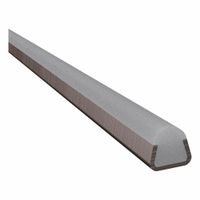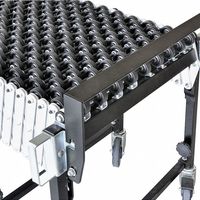Call +(254) 703 030 000 / 751 483 999 / 721 704 777
- Home
- Material Handling
- Transporting
- Conveyors Components
- Conveyor Guides
.....Read More
Frequently Asked Questions
What are the different types of conveyor guides available for unpowered and powered conveyor systems?
1. **Fixed Guides**: Used in both powered and unpowered systems, these guides are stationary and help maintain the alignment of items on the conveyor. They are typically made from metal or plastic and are ideal for straight-line movement.
2. **Adjustable Guides**: These guides can be repositioned to accommodate different sizes of products. They are commonly used in systems where product dimensions vary frequently, allowing for quick adjustments without the need for tools.
3. **Roller Guides**: Often used in unpowered systems, roller guides consist of small rollers that help guide items smoothly along the conveyor path. They reduce friction and are suitable for handling delicate or lightweight items.
4. **Side Guides**: Installed along the sides of the conveyor, these guides prevent items from falling off. They are essential in both powered and unpowered systems, especially when transporting items with irregular shapes.
5. **Overhead Guides**: Used in powered systems, these guides are positioned above the conveyor to stabilize tall or unstable items. They ensure that products remain upright and aligned during transport.
6. **Guide Rails**: Common in both powered and unpowered systems, guide rails are versatile and can be adjusted for height and width. They are used to direct the flow of products and prevent them from deviating from the path.
7. **Belt Guides**: Specific to belt conveyors, these guides ensure that the belt remains centered and does not drift off course. They are crucial for maintaining the efficiency and longevity of the conveyor system.
8. **Modular Guides**: These are customizable and can be configured to fit specific conveyor layouts. They are ideal for complex systems with multiple turns and elevations.
9. **Magnetic Guides**: Used in specialized applications, magnetic guides help control ferrous materials on the conveyor, ensuring precise movement and alignment.
How do you install conveyor guides onto an existing conveyor system?
1. **Assessment**: Evaluate the existing conveyor system to determine the type and size of guides needed. Consider the material, product size, and conveyor speed.
2. **Selection**: Choose the appropriate guide type (fixed, adjustable, or modular) and material (plastic, metal, or rubber) based on the assessment.
3. **Preparation**: Gather necessary tools and materials, such as brackets, screws, drills, and measuring tape. Ensure the conveyor is turned off and locked out for safety.
4. **Measurement**: Measure the conveyor width and product dimensions to determine the guide placement. Mark the positions where the guides will be installed.
5. **Installation of Brackets**: Attach mounting brackets to the conveyor frame at the marked positions. Use a drill to secure them with screws or bolts, ensuring they are aligned and level.
6. **Guide Attachment**: Attach the conveyor guides to the brackets. For adjustable guides, ensure they can be easily moved to accommodate different product sizes.
7. **Alignment**: Align the guides parallel to the conveyor belt. Use a level to ensure they are straight and adjust as necessary.
8. **Testing**: Turn on the conveyor system and run a test with products to ensure the guides are functioning correctly. Check for any misalignment or obstruction.
9. **Adjustment**: Make any necessary adjustments to the guide position or angle to ensure smooth product flow and prevent jamming.
10. **Final Check**: Conduct a final inspection to ensure all components are securely fastened and the system operates efficiently.
11. **Documentation**: Record the installation details, including guide type, position, and any adjustments made for future reference and maintenance.
What materials are commonly used for conveyor guides, and how do they affect performance?
Common materials used for conveyor guides include:
1. **Plastic (UHMW, HDPE, Nylon):**
- **UHMW (Ultra-High-Molecular-Weight Polyethylene):** Offers low friction, high wear resistance, and is ideal for reducing noise and energy consumption. It is suitable for high-speed applications.
- **HDPE (High-Density Polyethylene):** Provides good chemical resistance and is cost-effective, but has lower wear resistance compared to UHMW.
- **Nylon:** Known for its strength and toughness, it is used in applications requiring high impact resistance.
2. **Metal (Stainless Steel, Aluminum):**
- **Stainless Steel:** Offers excellent corrosion resistance and strength, making it suitable for harsh environments and heavy-duty applications. It is more expensive and can increase noise levels.
- **Aluminum:** Lightweight and corrosion-resistant, it is used in applications where weight reduction is crucial. However, it is less durable than stainless steel.
3. **Rubber:**
- Provides cushioning and grip, reducing product slippage and damage. It is used in applications where gentle handling is required.
4. **Composite Materials:**
- Combine properties of different materials to enhance performance, such as increased strength, reduced weight, or improved wear resistance.
**Performance Impact:**
- **Friction and Wear:** Materials with low friction and high wear resistance, like UHMW, enhance efficiency and longevity.
- **Noise Levels:** Plastic materials generally reduce noise compared to metals.
- **Corrosion Resistance:** Stainless steel and certain plastics are preferred in corrosive environments.
- **Cost and Maintenance:** Plastics are generally more cost-effective and require less maintenance than metals.
- **Application Suitability:** The choice of material affects the conveyor's suitability for specific environments, such as food processing or heavy industrial use.
How do conveyor guides help in minimizing wear and damage to items during conveying?
Conveyor guides play a crucial role in minimizing wear and damage to items during conveying by providing stability, alignment, and protection throughout the transportation process. They ensure that items remain on the correct path, reducing the risk of collisions and misalignment that can lead to damage. By maintaining a consistent position, conveyor guides prevent items from rubbing against the conveyor's sides or other items, which can cause wear and tear.
These guides are typically made from materials that are gentle on the items being conveyed, such as plastic or rubber, which further reduces the risk of scratching or damaging delicate surfaces. Additionally, conveyor guides can be adjusted to accommodate different sizes and shapes of items, ensuring that each item is securely held in place without excessive pressure that could cause deformation or breakage.
Furthermore, conveyor guides help in distributing the load evenly across the conveyor system, which minimizes stress on individual components and reduces the likelihood of mechanical failure. This even distribution also helps in maintaining a smooth flow of items, preventing sudden stops or starts that could jostle or damage the items.
In summary, conveyor guides enhance the efficiency and safety of the conveying process by ensuring proper alignment, reducing friction, and providing gentle handling of items. This not only minimizes wear and damage to the items but also extends the lifespan of the conveyor system itself, leading to reduced maintenance costs and downtime.
What are the best practices for maintaining and adjusting conveyor guides?
1. **Regular Inspection**: Conduct routine checks to identify wear, misalignment, or damage. Look for signs of friction or unusual noise.
2. **Proper Alignment**: Ensure guides are aligned correctly with the conveyor belt. Misalignment can cause product damage and increase wear.
3. **Lubrication**: Apply appropriate lubricants to reduce friction and wear. Use lubricants compatible with the materials being conveyed.
4. **Material Compatibility**: Choose guide materials that are compatible with the products being conveyed to prevent contamination or damage.
5. **Adjustability**: Use adjustable guides to accommodate different product sizes and shapes. This flexibility helps in maintaining efficiency.
6. **Secure Fastening**: Ensure all guide components are securely fastened to prevent movement during operation.
7. **Cleaning**: Regularly clean guides to remove debris and prevent buildup that can cause misalignment or damage.
8. **Training**: Train staff on proper maintenance procedures and the importance of guide adjustments to ensure consistent performance.
9. **Documentation**: Keep detailed records of maintenance activities, adjustments, and inspections to track performance and identify recurring issues.
10. **Replacement**: Replace worn or damaged guides promptly to prevent further damage to the conveyor system.
11. **Use of Sensors**: Implement sensors to monitor guide performance and detect issues early, allowing for timely intervention.
12. **Consult Manufacturer Guidelines**: Follow the manufacturer’s recommendations for maintenance and adjustments to ensure optimal performance.
13. **Safety Protocols**: Adhere to safety protocols during maintenance to protect personnel and equipment.
14. **Feedback Loop**: Establish a feedback loop with operators to report issues and suggest improvements for guide maintenance and adjustment.
How do you determine the right type of conveyor guide for specific applications?
To determine the right type of conveyor guide for specific applications, consider the following factors:
1. **Material Characteristics**: Assess the size, weight, shape, and fragility of the items being conveyed. Delicate items may require softer guides, while heavier items need robust guides.
2. **Conveyor Type**: Match the guide to the conveyor system (e.g., belt, roller, chain) to ensure compatibility and efficiency.
3. **Environment**: Consider the operating environment, including temperature, humidity, and exposure to chemicals. Use corrosion-resistant materials in harsh conditions.
4. **Load Capacity**: Ensure the guide can handle the maximum load without deformation or failure.
5. **Speed and Flow**: High-speed applications may require guides with low friction to prevent wear and tear.
6. **Flexibility and Adjustability**: For systems with varying product sizes, adjustable guides offer versatility.
7. **Installation and Maintenance**: Choose guides that are easy to install and maintain to minimize downtime.
8. **Cost**: Balance the initial cost with long-term benefits like durability and reduced maintenance.
9. **Regulatory Compliance**: Ensure the guide materials meet industry standards and regulations, especially in food or pharmaceutical applications.
10. **Supplier Support**: Consider the availability of technical support and customization options from the supplier.
By evaluating these factors, you can select a conveyor guide that optimizes performance, enhances safety, and meets the specific needs of your application.
Can conveyor guides be customized for unique conveyor system requirements?
Yes, conveyor guides can be customized for unique conveyor system requirements. Customization is often necessary to accommodate specific operational needs, product types, and environmental conditions. Conveyor guides are essential components that help in directing and positioning products on the conveyor belt, ensuring smooth and efficient transport.
Customization can involve several aspects:
1. **Material Selection**: Depending on the product being conveyed and the operating environment, guides can be made from various materials such as stainless steel, plastic, or aluminum. For instance, food-grade materials are used in the food industry to meet hygiene standards.
2. **Design and Shape**: The design of the guides can be tailored to fit the shape and size of the products. This includes straight, curved, or angled guides to manage product flow and prevent spillage or misalignment.
3. **Adjustability**: Custom guides can be designed to be adjustable, allowing for flexibility in handling different product sizes and shapes. This is particularly useful in systems that handle a variety of products.
4. **Mounting Options**: Custom mounting solutions can be developed to fit specific conveyor frames or to integrate with existing equipment seamlessly.
5. **Special Features**: Additional features such as anti-static properties, high-temperature resistance, or corrosion resistance can be incorporated to meet specific operational challenges.
6. **Integration with Automation**: For systems that require automation, guides can be customized to work with sensors and other automated components to enhance efficiency and reduce manual intervention.
By customizing conveyor guides, businesses can optimize their conveyor systems for improved performance, reduced downtime, and increased productivity, ultimately leading to cost savings and enhanced operational efficiency.

